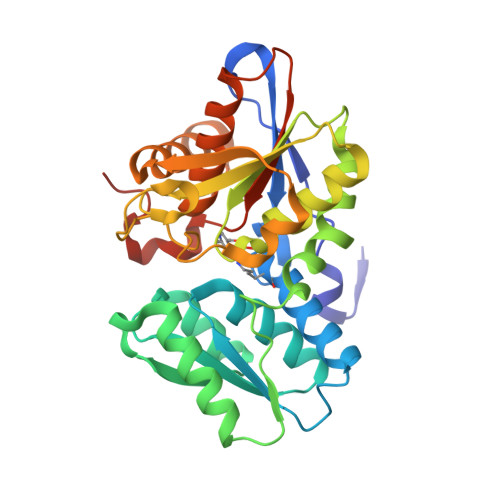Crystallographic and mutational analyses of cystathionine beta-synthase in the H2 S-synthetic gene cluster in Lactobacillus plantarum
Matoba, Y., Yoshida, T., Izuhara-Kihara, H., Noda, M., Sugiyama, M.(2017) Protein Sci 26: 763-783
- PubMed: 28127810
- DOI: https://doi.org/10.1002/pro.3123
- Primary Citation of Related Structures:
5B1H, 5B1I - PubMed Abstract:
Cystathionine β-synthase (CBS) catalyzes the formation of l-cystathionine from l-serine and l-homocysteine. The resulting l-cystathionine is decomposed into l-cysteine, ammonia, and α-ketobutylic acid by cystathionine γ-lyase (CGL). This reverse transsulfuration pathway, which is catalyzed by both enzymes, mainly occurs in eukaryotic cells. The eukaryotic CBS and CGL have recently been recognized as major physiological enzymes for the generation of hydrogen sulfide (H 2 S). In some bacteria, including the plant-derived lactic acid bacterium Lactobacillus plantarum, the CBS- and CGL-encoding genes form a cluster in their genomes. Inactivation of these enzymes has been reported to suppress H 2 S production in bacteria; interestingly, it has been shown that H 2 S suppression increases their susceptibility to various antibiotics. In the present study, we characterized the enzymatic properties of the L. plantarum CBS, whose amino acid sequence displays a similarity with those of O-acetyl-l-serine sulfhydrylase (OASS) that catalyzes the generation of l-cysteine from O-acetyl-l-serine (l-OAS) and H 2 S. The L. plantarum CBS shows l-OAS- and l-cysteine-dependent CBS activities together with OASS activity. Especially, it catalyzes the formation of H 2 S in the presence of l-cysteine and l-homocysteine, together with the formation of l-cystathionine. The high affinity toward l-cysteine as a first substrate and tendency to use l-homocysteine as a second substrate might be associated with its enzymatic ability to generate H 2 S. Crystallographic and mutational analyses of CBS indicate that the Ala70 and Glu223 residues at the substrate binding pocket are important for the H 2 S-generating activity.
- Graduate School of Biomedical and Health Sciences, Hiroshima University, Kasumi 1-2-3, Minami-ku, Hiroshima, 734-8551, Japan.
Organizational Affiliation:



















